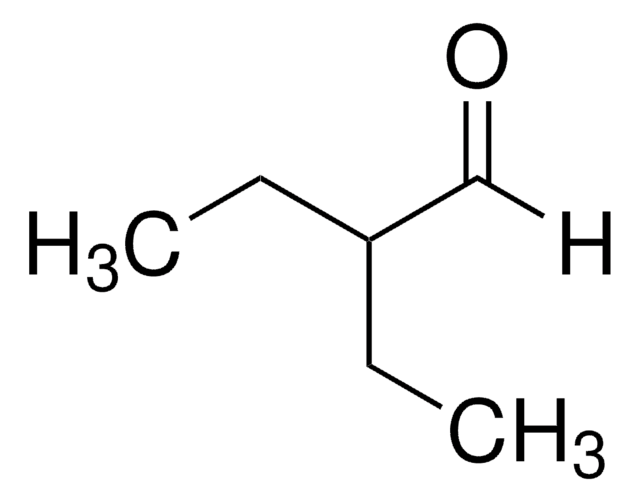W269107
2-Methylbutyraldehyde
≥95%, FG
Synonym(s):
2-Methylbutanal
About This Item
Recommended Products
biological source
synthetic
Quality Level
grade
FG
Fragrance grade
Halal
Kosher
Agency
(EU Regulation 1223/2009)
(follows IFRA guidelines)
reg. compliance
EU Regulation 1334/2008 & 178/2002
FDA 21 CFR 117
FDA 21 CFR 172.515
Assay
≥95%
impurities
<5% isopentanal
refractive index
n20/D 1.3919 (lit.)
bp
90-92 °C (lit.)
density
0.806 g/mL at 20 °C
0.804 g/mL at 25 °C (lit.)
application(s)
flavors and fragrances
Documentation
see Safety & Documentation for available documents
food allergen
no known allergens
fragrance allergen
no known allergens
Organoleptic
chocolate; coffee
SMILES string
[H]C(=O)C(C)CC
InChI
1S/C5H10O/c1-3-5(2)4-6/h4-5H,3H2,1-2H3
InChI key
BYGQBDHUGHBGMD-UHFFFAOYSA-N
Looking for similar products? Visit Product Comparison Guide
General description
Application
- In Staphylococcus aureus, the acyl-CoA synthetase MbcS supports branched-chain fatty acid synthesis from carboxylic acid and aldehyde precursors.: This study explores the role of the enzyme MbcS in Staphylococcus aureus, demonstrating how it utilizes 2-Methylbutyraldehyde as a precursor in the synthesis of branched-chain fatty acids, which are essential for bacterial growth and virulence (Dos Santos Ferreira et al., 2024).
- Volatile Short-Chain Aliphatic Aldehydes Act as Taste Modulators through the Orally Expressed Calcium-Sensing Receptor CaSR.: This study investigates how volatile short-chain aldehydes, including 2-Methylbutyraldehyde, modulate taste perception through the calcium-sensing receptor CaSR, providing insights into their potential applications in food and flavor industries (Kitajima et al., 2023).
Signal Word
Danger
Hazard Statements
Precautionary Statements
Hazard Classifications
Aquatic Chronic 2 - Eye Irrit. 2 - Flam. Liq. 2 - Skin Sens. 1 - STOT SE 3
Target Organs
Respiratory system
Storage Class Code
3 - Flammable liquids
WGK
WGK 2
Flash Point(F)
23.0 °F
Flash Point(C)
-5 °C
Personal Protective Equipment
Certificates of Analysis (COA)
Search for Certificates of Analysis (COA) by entering the products Lot/Batch Number. Lot and Batch Numbers can be found on a product’s label following the words ‘Lot’ or ‘Batch’.
Already Own This Product?
Find documentation for the products that you have recently purchased in the Document Library.
Customers Also Viewed
Our team of scientists has experience in all areas of research including Life Science, Material Science, Chemical Synthesis, Chromatography, Analytical and many others.
Contact Technical Service













